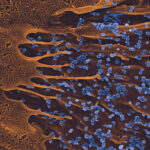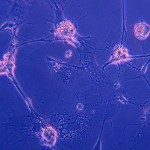The Invasive Bacterial Infections Unit (IBI) was created on January 1st, 2009. The works at the IBI unit combine research on molecular pathogenesis, pathophysiological aspects of Neisseria meningitidis (Nm) and reference activities of the National Reference Centre for Meningococci and the WHO collaborating centre. During the year 2012, two areas of work were developed:
- Analysis of the interactions between host cells and N. meningitidis and comprehensive analysis of the pathogenesis of N. meningitidis;
- Applied research in the field of molecular epidemiology and vaccine development.
N. meningitidis, or meningococcus, is a Gram-negative bacterium surrounded by a capsule composed of polysaccharides that determines the serogroup of the meningococcus. This bacterium is known to be restricted to humans; its natural habitat is the upper respiratory tract, where it establishes a commensal relationship (carriage) that involves around 10% of the general population. N. meningitidis is acquired and transmitted through respiratory droplets during close inter-human contacts. It first colonizes the mucosa of the human nasopharynx. Some meningococcal isolates are able to cross the epithelial barrier to invade blood (invasive infections) and provoke meningococcal disease. N. meningitidis is an important cause of life-threatening invasive bacterial infections in infants, children, adolescents, and young adults.
Meningococcal disease occurs as sporadic cases in Europe, North America, Australia, and New Zealand with localized outbreaks. The incidence is much higher in countries within the meningitis belt in sub-Saharan Africa where major periodic epidemics occur.







